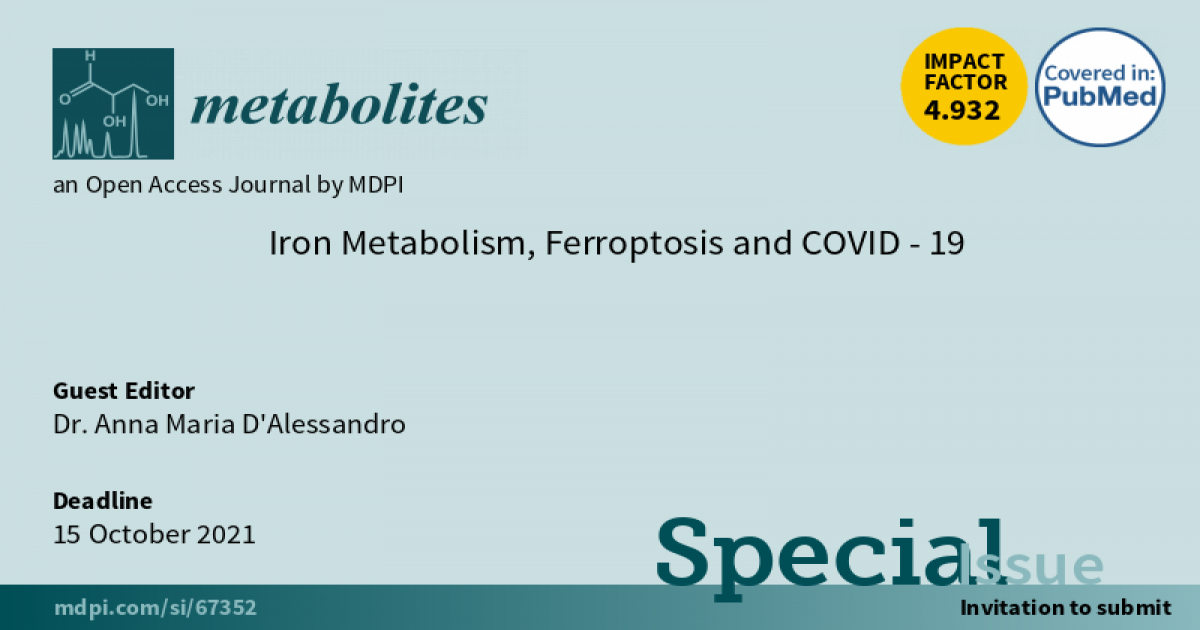Iron Metabolism, Ferroptosis and COVID-19
A special issue of Metabolites (ISSN 2218-1989). This special issue belongs to the section "Cell Metabolism".
Deadline for manuscript submissions: closed (15 October 2021) | Viewed by 5234

Special Issue Editor
Interests: the biochemical pathways for defense against oxidative stress and the relations between the oxidation state and iron metabolism in chronic diseases and in reproductive aging and infertility; the study of the anti-oxidant, anti-proliferative and anti-inflammatory effects of saffron and its carotenoids
Special Issue Information
Dear Colleagues,
Iron is a transition metal and essential constituent of almost all living cells and organisms. It is a component of various metalloproteins and is involved in critical biochemical processes such as the transport of oxygen in tissues, electron transfer reactions during mitochondrial respiration, the synthesis and repair of DNA, the metabolism of xenobiotics, etc. When present in excess within cells and tissues, iron disrupts redox homeostasis and catalyzes the propagation of reactive oxygen species (ROS), leading to oxidative stress. At the cellular level, oxidative stress may lead to ferroptosis, an iron-dependent form of cell death. Ferroptosis plays an important regulatory role in the occurrence and development of many diseases, such as nervous system diseases including ageusia and anosmia, ischemia/reperfusion injury, tumors etc.
The novel 2019 coronavirus disease (COVID-19) causes acute respiratory distress syndrome (ARDS) in vulnerable individuals. Emerging data link the risk of severe COVID-19 with certain factors such as hyper-inflammation, involving a cytokine storm. Proinflammatory cytokines such as IL6 may induce hyper-ferritinemia in COVID-19 patients. Ferritin is the primary site of iron storage in the cell, and its increase is regulated by the protein hepcidin, a key regulator of iron metabolism in humans.
Recently, a distant sequence similarity between the cysteine-rich cytoplasmic tail of the coronavirus spike protein and the hepcidin protein was reported. This preliminary observation may suggest a potential route of investigation in the coronavirus research field based on the interplay of local and systemic iron regulation, cytokine-mediated inflammatory processes, respiratory infections and the hepcidin protein.
Therefore, this Special Issue of Metabolites will be dedicated to publishing current advances in iron homeostasis, oxidative stress, ferroptosis and COVID-19.
Dr. Anna Maria D'Alessandro
Guest Editor
Manuscript Submission Information
Manuscripts should be submitted online at www.mdpi.com by registering and logging in to this website. Once you are registered, click here to go to the submission form. Manuscripts can be submitted until the deadline. All submissions that pass pre-check are peer-reviewed. Accepted papers will be published continuously in the journal (as soon as accepted) and will be listed together on the special issue website. Research articles, review articles as well as short communications are invited. For planned papers, a title and short abstract (about 100 words) can be sent to the Editorial Office for announcement on this website.
Submitted manuscripts should not have been published previously, nor be under consideration for publication elsewhere (except conference proceedings papers). All manuscripts are thoroughly refereed through a single-blind peer-review process. A guide for authors and other relevant information for submission of manuscripts is available on the Instructions for Authors page. Metabolites is an international peer-reviewed open access monthly journal published by MDPI.
Please visit the Instructions for Authors page before submitting a manuscript. The Article Processing Charge (APC) for publication in this open access journal is 2700 CHF (Swiss Francs). Submitted papers should be well formatted and use good English. Authors may use MDPI's English editing service prior to publication or during author revisions.
Keywords
- iron
- oxidative stress
- hepcidin
- ferritin
- ferroptosis
- COVID-19
- endothelial cells
- hypoxia
- inflammation
- ARDS
Benefits of Publishing in a Special Issue
- Ease of navigation: Grouping papers by topic helps scholars navigate broad scope journals more efficiently.
- Greater discoverability: Special Issues support the reach and impact of scientific research. Articles in Special Issues are more discoverable and cited more frequently.
- Expansion of research network: Special Issues facilitate connections among authors, fostering scientific collaborations.
- External promotion: Articles in Special Issues are often promoted through the journal's social media, increasing their visibility.
- e-Book format: Special Issues with more than 10 articles can be published as dedicated e-books, ensuring wide and rapid dissemination.
Further information on MDPI's Special Issue polices can be found here.






